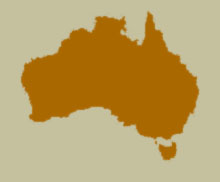Synonyms
Coccinella circumdatus Gyllenhal in Schönherr, 1808: 152.
Diagnosis
The reddish elytra with dark borders will easily distinguish this species from the other Australian Chilocorus. Other distinctive characters are the presence of an almost complete bordering line at pronotal base, a densely pubescent metaventrite, discreet hypomeral fovea and a polished surface of the head.
Description
Length 4.2-5.9 mm. Surface predominantly yellowish brown or reddish brown, with a dark brown lateral margin of elytra, from the humerus to the apex; a brownish "V" mark occurs on the metaventrite of some individuals. Head flat between eyes; polished between punctures; punctation about as large as eye facets, nearly 0.5 diameters apart. Eyes dorsally separated by slightly less than 2 times the width of an eye; inner ocular margin nearly parallel. Antennomere 8 long, about as long as 6th and 7th combined. Clypeus not projecting forward; slightly emarginate. Terminal maxillary palpomere slightly expanded toward apex; terminal labial palpomere long, about 4 times longer than basal width, longer than preceding segment. Pronotal surface polished between punctures; punctation smaller than eye facets, shallower and sparser than on head, approximately 2 to 3 diameters apart, getting deeper and more concentrated on anterior angles; lateral borders oblique; bordering line present at base, the line visible only on outer margin of anterior angles; prosternum relatively short, about as long as to slightly shorter than prosternal process widest width; hypomeral fovea vestigial, drop-shaped; metaventrite densely covered with long pubescence. Elytral surface polished between punctures; punctation stronger than on pronotum, slightly deeper and more concentrated, about as large as eye facets, larger at the lateral margin; epipleura foveae discreet. Abdomen with ventrite 6 very short, broadly rounded; surface of ventrite 1 polished between postcoxal lines.
Male
Tegmen relatively short, about 1/2 the abdomen length; penis guide symmetrical, about as long as parameres; parameres densely setose at apex, the setae long; strut as long as tegmen; penis similar to C. malasiae.
Female
Female externally similar to male.
Variation
UNDER CONSTRUCTION
 Distribution and Biology
Distribution and Biology
India, Sri Lanka, Indonesia, China, and Hong Kong. Introduced to Australia. This ispecies was first observed in Queensland in 1990, feeding on citrus snow scale, Unaspis citri (Comstock). Since its discovery in Queensland it has been propagated and released in many citrus growing areas of the territory. It is credited with suppressing U. citri to sub economic levels in most of the orchards.
Species References
Schönherr, C.J. 1808. Synonyma Insectorum, oder: Versuch einer Synonymie aller bisher bekannten Insecten; nach Fabricii Systema Eleutheratorum &c. geordnet. Erster Band. Eleutherata oder Käfer. Zweiter Theil. Stockholm : C.F. Marquard x + 424 pp. 1 pl.
Slipinski, S.A. 2007. Australian Ladybird Beetles (Coleoptera: Coccinellidae) their biology and classification. ABRS, Canberra. 286 pp.
Slipinski, A. and Giorgi, J.A. 2006. Revision of the Australian Coccinellidae (Coccinellidae). Part 6. Tribe Chilocorini. Annales Zoologici (Warszawa), 56(2): 265-304.
[ Top ]
